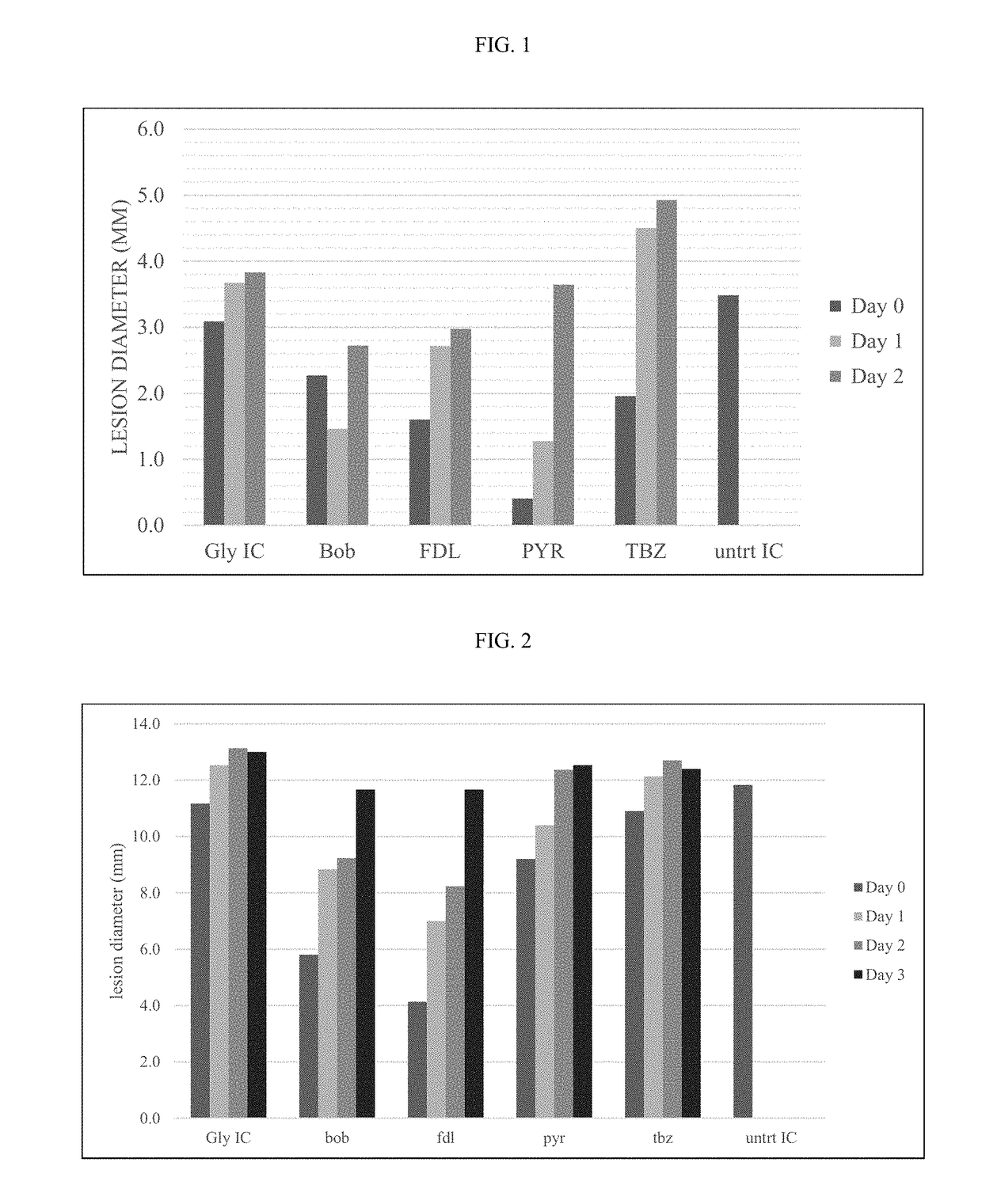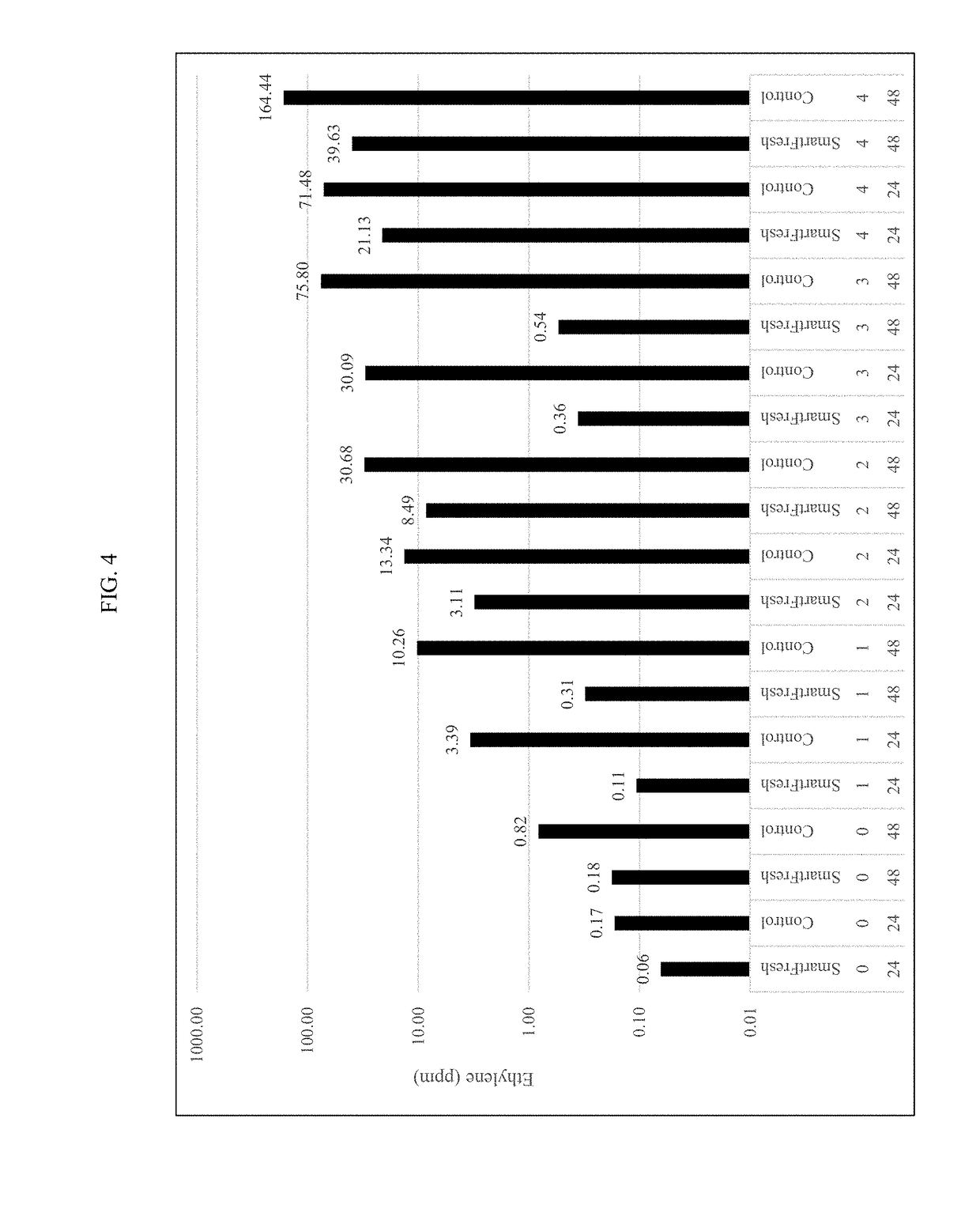Methods and device for co-treatment of crop protection chemicals with plant growth regulators
a technology of crop protection chemicals and plant growth regulators, which is applied in the field of methods and devices for co-treatment of crop protection chemicals with plant growth regulators, can solve the problems of difficult control of application rate, difficult to control application rate, and all crops are not amenable to spraying and drenching application methods of pesticides
- Summary
- Abstract
- Description
- Claims
- Application Information
AI Technical Summary
Benefits of technology
Problems solved by technology
Method used
Image
Examples
example 1
of Fungicide Treatment of Fungal Growth Inhibition on Golden Delicious Apples
[0258]Freshly harvested plants and crops, such as fruit crops (e.g. apple fruits), were wounded and inoculated with fungal pathogens. Immediately after harvest on Day 0, Golden Delicious apples were wounded on the left and / or the right sides of the fruit. The wounds were immediately inoculated with one or more fungal strains. For example, the wounds on the left side of the fruit were inoculated with Penicillium, while the wounds on the right side of the fruit were inoculated with Botrytis. After inoculation, the apples remained at 20° C. throughout the remainder of the experimental trial.
[0259]Inoculated fruits were separated in preparation for an experimental trial that comprised three replicates of 10-fruit cohorts each totaling 5.1 kg of Golden Delicious apples (see Table 1). After inoculation, the apples were held at 20° C. in a closed, controlled environment until fungicide treatment. Prior to fungicid...
example 4
of Cyclopropene Treatment on Ethylene Production of Golden Delicious Apples
[0284]Freshly harvested Golden Delicious apples were separated in preparation for an experimental trial that comprised three replicates of 60-fruit cohorts each totaling 30.6 kg of Golden Delicious apples (see Table 6). Immediately after harvest, the fruit cohorts were each treated for 24 hours in a sealed chamber at 20° C. with a concentration of SmartFresh 1-MCP (see Table 6). Different fruit cohorts were treated with SmartFresh for 24 hours beginning on Days 0, 1, 2, 3, and / or 4 after harvest (see Table 7).
[0285]More specifically, each fruit cohort of this trial was treated a single time for 24 hours at 20° C. with a SmartFresh solution comprising 3.8% of active 1-MCP (see Table 6). In particular, the SmartFresh solution was applied to the Golden Delicious apples in the sealed treatment chamber comprising a volume of 28.4 m3 such that the final concentration of active 1-MCP applied to the apples during the...
example 5
of Cyclopropene Treatment on Ethylene Production of Red Delicious Apples
[0292]This experiment was conducted exactly the same as described above in Example 4 unless noted otherwise. For example, instead of Golden Delicious apples, this experiment was performed on Red Delicious apples, which are harvested later in the season than Golden Delicious apples. Freshly harvested Red Delicious apples were separated in preparation for an experimental trial that comprised three replicates of 60-fruit cohorts each totaling 33.0 kg of Red Delicious apples (see Table 6). Immediately after harvest, the fruit cohorts were each treated for 24 hours in a sealed chamber at 20° C. with a concentration of SmartFresh 1-MCP (see Table 6). Different fruit cohorts were treated with SmartFresh for 24 hours beginning on Days 0, 1, 2, 3, and / or 4 after harvest (see Table 7).
[0293]After completion of the 1-MCP treatment, treated apples were removed from the sealed treatment chamber and stored at 20° C. in a clos...
PUM
 Login to View More
Login to View More Abstract
Description
Claims
Application Information
 Login to View More
Login to View More - R&D
- Intellectual Property
- Life Sciences
- Materials
- Tech Scout
- Unparalleled Data Quality
- Higher Quality Content
- 60% Fewer Hallucinations
Browse by: Latest US Patents, China's latest patents, Technical Efficacy Thesaurus, Application Domain, Technology Topic, Popular Technical Reports.
© 2025 PatSnap. All rights reserved.Legal|Privacy policy|Modern Slavery Act Transparency Statement|Sitemap|About US| Contact US: help@patsnap.com



